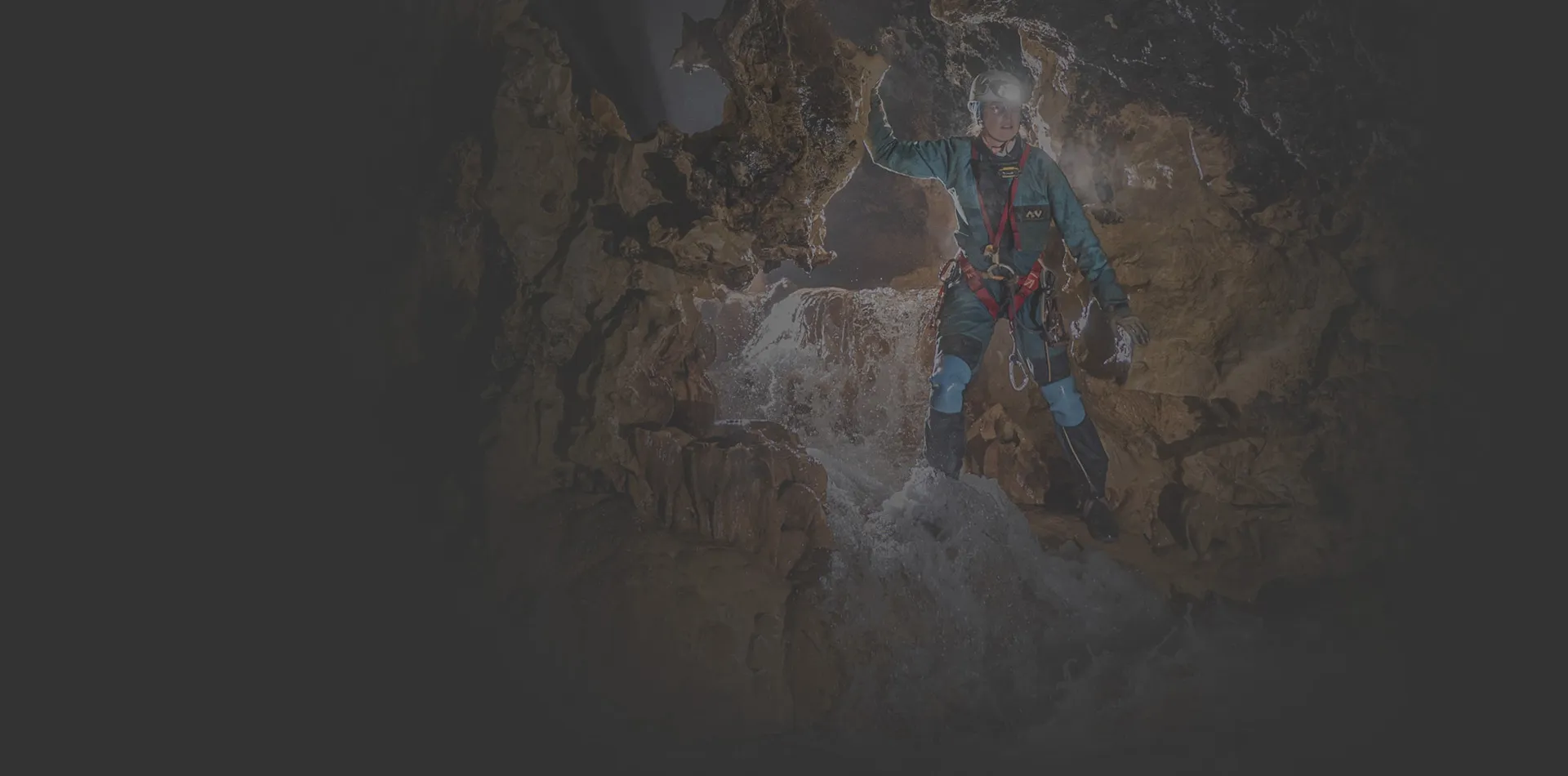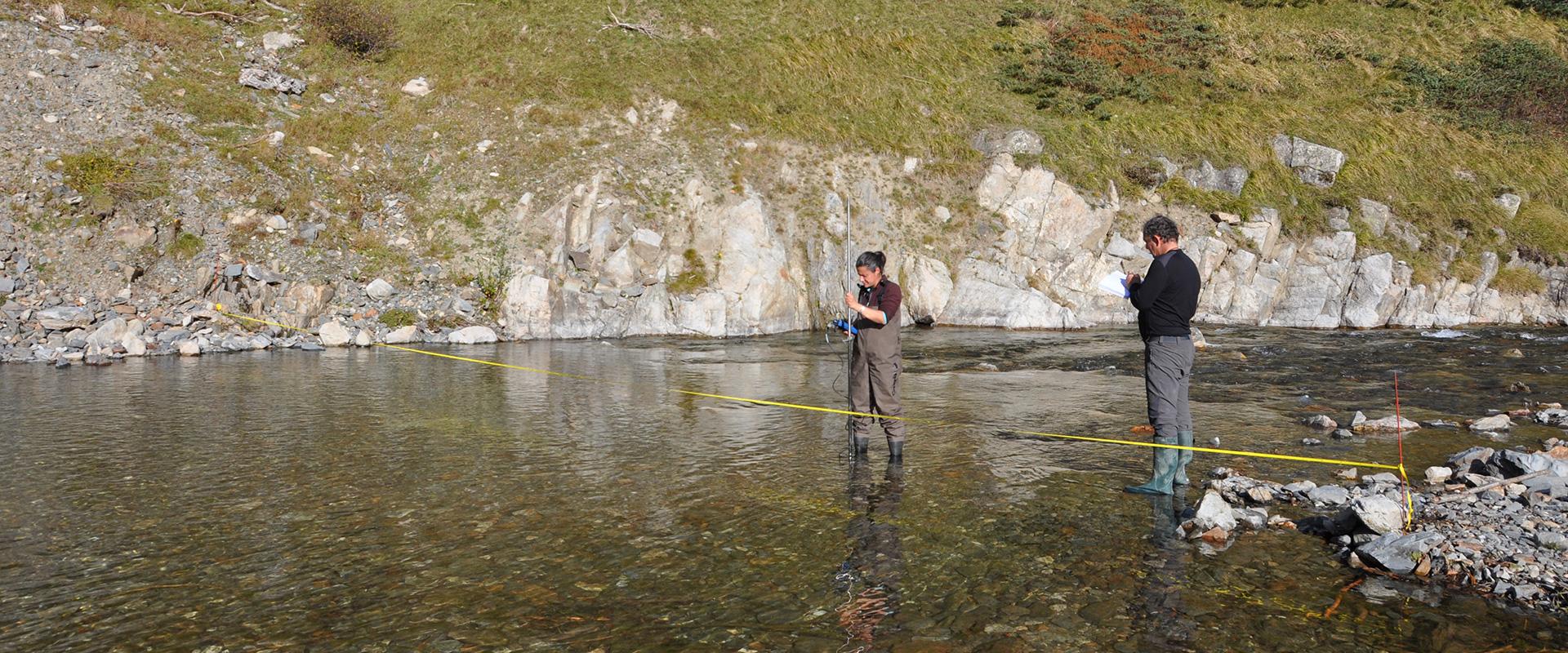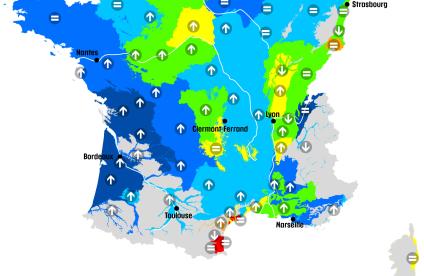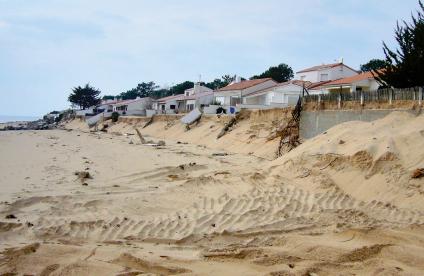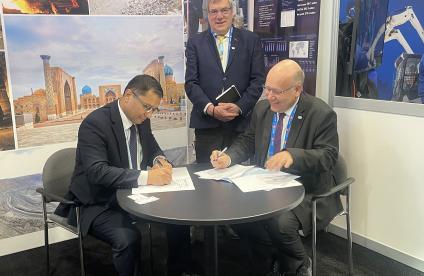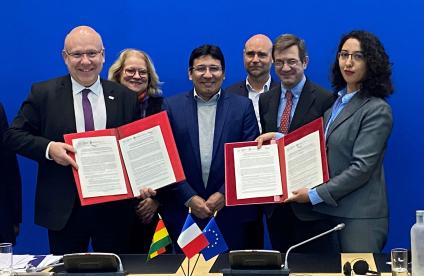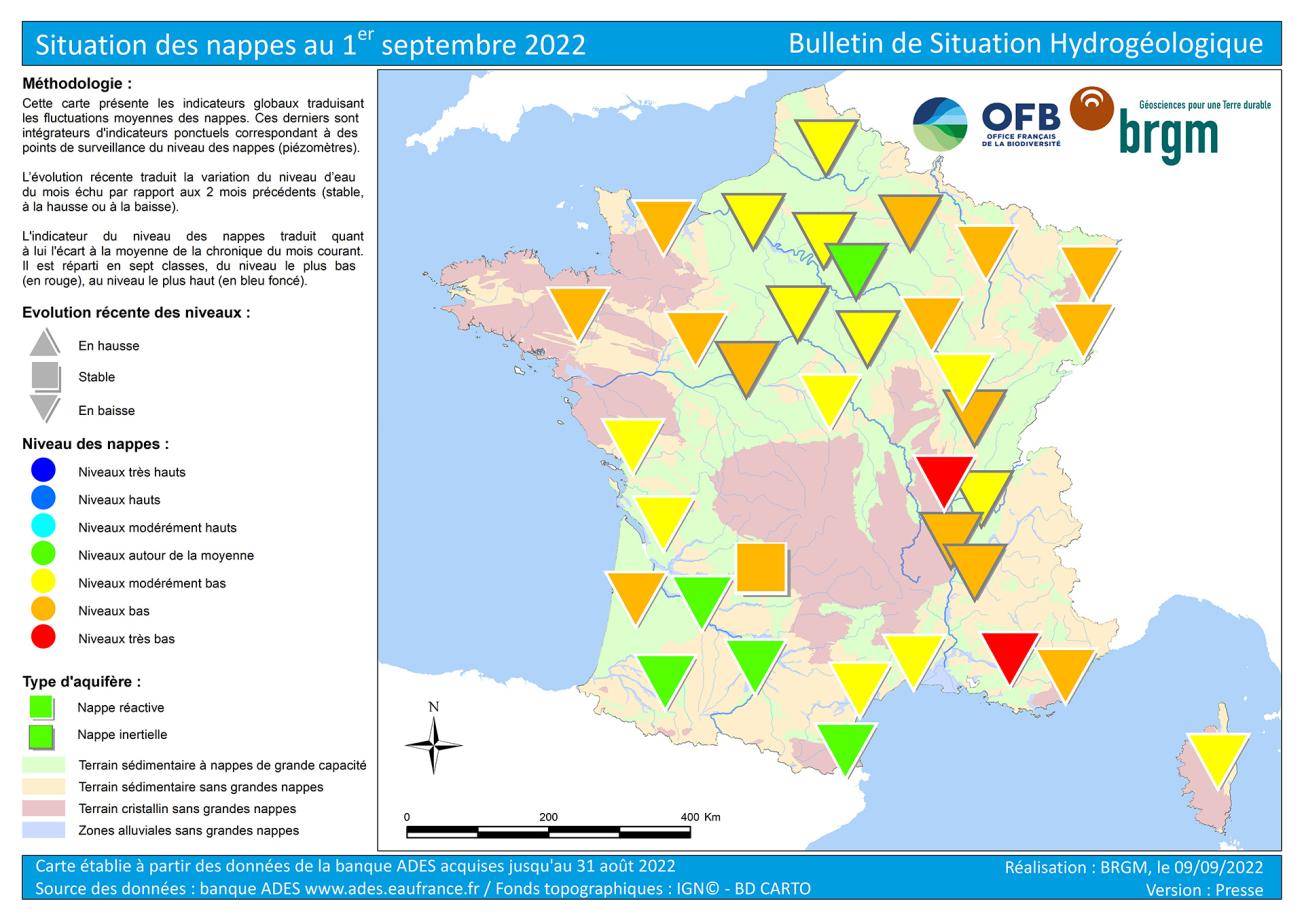
Map of groundwater tables in France on 1 September 2022
© BRGM
Situation hydrogéologique au 1er septembre 2022
En août, les niveaux des nappes sont globalement en baisse. Les pluies estivales n’ont eu qu’un impact très limité sur les eaux souterraines. La décharge semble toutefois ralentie depuis juillet, conséquence probable de la limitation des prélèvements. L’état de remplissage des nappes demeure peu satisfaisant sur la plupart d’entre elles, voire inquiétant avec des niveaux bas à très bas observés sur près de la moitié du territoire. La situation est particulièrement préoccupante au sud-est, sur le Bas-Dauphiné, la Provence et la Côte-d’Azur. Les nappes des calcaires karstiques du Vaucluse et du centre Var sont en phase de tarissement, laissant présager un étiage très marqué.
Les tendances des nappes devraient rester orientées vers la baisse jusqu’à la période d’étiage (basses eaux), qui s’observe habituellement entre mi-octobre et novembre. Les pluies efficaces devraient tout d’abord permettre d’humidifier les sols et bénéficier à la végétation, avant de réussir à s’infiltrer en profondeur.
L’étiage 2022 devrait être particulièrement sévère sur la plupart des nappes, à l’exception du sud-ouest. Les niveaux des nappes à l’entrée d’hiver 2022-2023 seront nettement inférieurs à ceux de l’année dernière. La recharge 2022-2023 conditionnera donc les niveaux de l’année prochaine. Elle devra être particulièrement abondante et longue pour permettre aux réserves de se reconstituer. La situation devra être surveillée sur l’ensemble du territoire jusqu’à l’étiage puis durant toute la période de recharge.
Tendances d’évolution
L’ensemble des nappes du territoire ont bénéficié d’une recharge hivernale 2021-2022 courte et nettement inférieure à la normale. Les nappes ont débuté leur vidange entre janvier et mars, soit avec deux à trois mois d’avance, et les niveaux sont généralement restés orientés à la baisse durant tout le printemps et l’été. Durant le printemps, les déficits pluviométriques conjugués à une forte demande en eau se sont traduits par une décharge des nappes plus rapide que la normale.
En août, la quasi-totalité des nappes affichent des niveaux en baisse. Les nappes se vidangent naturellement vers les cours d’eau, permettant ainsi un soutien de leur étiage, et sont sollicitées par les prélèvements. L’intensité de la vidange s’est ralentie en juillet et en août sur de nombreuses nappes du territoire. Ce constat peut s’expliquer par une limitation des prélèvements et par des épisodes ponctuels de recharge suite à des pluies efficaces locales.
Les épisodes orageux d’août n’ont cependant eu que peu d’impact sur les nappes. La part des pluies infiltrées en profondeur reste faible à inexistante en raison de sols très secs et de la consommation de ces eaux par la végétation. Localement les pluies ont entrainé de petites recharges ponctuelles. Ainsi, les tendances sont stables sur les nappes des calcaires karstifiés libres situées dans les Causses. Sur le sud-est, les précipitations ont été inefficaces à recharger les nappes même si de petites hausses momentanées ont pu être observées.
Situation par rapport aux moyennes des mois de juillet
Suite à une recharge 2021-2022 courte et peu abondante, l’état des nappes à la sortie d’hiver était peu satisfaisant. La situation s’est dégradée rapidement durant le printemps, du fait d’une forte sollicitation des eaux souterraines, et plus graduellement durant l’été.
Depuis juillet, l’état des nappes n’évolue en effet que peu. Ce constat s’explique par de faibles pluies efficaces locales et, plus probablement, par la diminution des demandes en eau. La prise d’arrêtés de restrictions d’usage de l’eau a permis de diminuer les volumes prélevés et ainsi de réduire la pression sur les eaux souterraines. En août, les niveaux demeurent cependant peu satisfaisants et se situent autour de la moyenne mensuelle à très bas.
L’inertie des nappes du nord de la France et du couloir Rhône-Saône implique une forte résistance aux sécheresses estivales. La situation de ces nappes reste ainsi quasiment identique depuis juin. Les niveaux sont bas à autour de la moyenne au droit des nappes du Bassin parisien. La situation est toutefois souvent hétérogène localement, notamment sur les secteurs fortement sollicités par des prélèvements. Les niveaux sont plus préoccupants, de modérément bas à bas sur les nappes du couloir Rhône-Saône.
Les nappes réactives sont sensibles à l’absence de pluies efficaces et la situation se dégrade progressivement entre juillet et août. Les niveaux sont préoccupants sur une grande partie du territoire, de modérément bas à très en-dessous des normales mensuelles. Ils restent satisfaisants et proches des normales au sud-ouest.
Plusieurs nappes présentent des situations favorables, avec des niveaux autour des normales par rapport aux mois d’août des années antérieures :
- Les niveaux des nappes des formations tertiaires de la Brie au Tardenois, inertielles et résistantes à la sécheresse, restent proches des normales depuis juin 2022 ;
- Les nappes alluviales de l’Adour et du Gave de Pau ainsi que de la Garonne, de la Dordogne et de leurs principaux affluents ont profité de plusieurs épisodes de recharge durant le printemps et conservent des niveaux proches des normales mensuelles ;
- Les niveaux des nappes de la plaine du Roussillon sont globalement comparables aux normales mais hétérogènes, de modérément bas sur la nappe superficielle quaternaire à hauts sur la nappe profonde pliocène.
De nombreuses nappes présentent des situations peu favorables avec des niveaux bas à très bas par rapport à tous les mois d’août des années précédentes :
- Au nord-est, la situation continue de se dégrader et les niveaux sont bas sur les nappes de la craie champenoise, des calcaires jurassiques de Lorraine à la Côte-des-Bar et des alluvions de la plaine d’Alsace ;
- Au centre-ouest, les niveaux des nappes du socle du Massif armoricain, des calcaires jurassiques du Bessin, du Poitou et de la Brenne, des sables du Maine et de la craie de Touraine sont bas voire localement très bas, conséquences des déficits pluviométriques durant l’hiver et le printemps ;
- Au centre-est, les niveaux des nappes inertielles des cailloutis plio-quaternaires de Bourgogne-Franche-Comté, des alluvions et corridors fluvio-glaciaires du Rhône moyen et de la molasse miocène du Bas-Dauphiné sont bas à très bas, héritage de plusieurs recharges successives déficitaires et d’une dégradation progressive depuis le début de l’année ;
- Au sud-est, les niveaux des nappes des alluvions et des formations complexes de Provence et de la Côte d’Azur sont toujours préoccupants, de bas à très bas, du fait de faibles recharges en 2020-2021 puis en 2021-2022. A noter que les ressources des calcaires karstiques du Vaucluse et du centre Var sont en phase de tarissement, annonçant un étiage sévère.
Prévisions
Les prévisions saisonnières de Météo-France annoncent des conditions plus chaudes qu’habituellement pour le prochain trimestre. Aucun scénario ne se dégage pour les précipitations. Des cumuls de pluviométrie importants, tels que des épisodes méditerranéens intenses, pourraient cependant survenir ponctuellement et localement.
En septembre, les épisodes pluviométriques ne devraient pas engendrer une recharge significative des nappes. En effet, les sols actuellement extrêmement secs et les pluies orageuses favorisent le ruissellement. De plus, les pluies réussissant à s’infiltrer devraient dans un premier temps permettre d’humidifier les sols et bénéficier à la végétation. Les pluies efficaces ne devraient donc pas réussir à s’infiltrer en profondeur jusqu’aux nappes.
La situation devrait se maintenir courant septembre ou se dégrader plus ou moins rapidement selon la demande en eau et la sensibilité des nappes à la sécheresse. En cas de pluies locales conséquentes, la situation pourrait cependant s’améliorer momentanément sur les nappes les plus réactives. Les niveaux ne devraient toutefois pas remonter au-dessus des normales de septembre sur les nappes affichant des niveaux actuels bas à très bas.
A moyen terme, la vidange devrait se poursuivre jusqu’à la mise en dormance de la végétation et la survenance de pluies conséquentes. Les tendances et l’évolution des situations dépendront essentiellement des pluies efficaces locales, des demandes en eau et de l’inertie/réactivité de la nappe.
Concernant les nappes inertielles, les niveaux ne devraient pas remonter avant mi-octobre à novembre et aucune amélioration n’est attendue avant le milieu de l’automne. La situation pourrait être préoccupante, avec un étiage sévère, sur les nappes inertielles du couloir Rhône-Saône et sur les nappes du sud (Touraine et sud Beauce) et du nord-est (Champagne) du Bassin parisien.
Concernant les nappes réactives, un étiage particulièrement sévère est attendu sur de nombreux secteurs, à l’exception de celles du sud-ouest. En cas de pluies insuffisantes, de nombreuses nappes réactives pourraient atteindre des seuils bas à très bas d’ici septembre-octobre.
Sur les prochaines semaines, en absence de pluies efficaces suffisantes, l’unique solution pour préserver l’état des nappes et maintenir la continuité entre eaux souterraines et eaux superficielles est de limiter les prélèvements en eau. Les arrêtés de restrictions d’usage permettent d’alléger la pression exercée sur la ressource en eau. Le ralentissement de la décharge permet d’éviter des dégradations rapides de l’état des nappes et repousse l’arrivée d’un étiage sévère dans l’attente de pluies efficaces. Toutefois, compte tenu de le situation actuelle, les niveaux des nappes à l’entrée d’hiver 2022-2023 seront nettement inférieurs à ceux de l’année dernière avec une majorité de nappes avec des niveaux bas à très bas.
Durant l’automne, l’hiver et le début du printemps, la situation devra être surveillée sur l’ensemble des nappes du territoire et plus particulièrement sur les nappes ayant enregistré un étiage sévère. La reconstitution des réserves en eau souterraine et l’atteinte de niveaux normaux en sortie d’hiver 2023 ne sera possible que si la recharge est abondante pendant l’automne et l’hiver. A noter que les pluies printanières permettront également de repousser le début de la période de vidange des nappes les plus réactives.
Contact presse

Bulletin de situation hydrologique
Le bulletin national de situation hydrologique est constitué d’un ensemble de cartes et de leurs commentaires qui présentent l’évolution mensuelle des ressources en eau. Il décrit la situation quantitative des milieux aquatiques (pluies efficaces, débits des cours d’eau, niveau des nappes d’eau souterraine, état de remplissage des barrages-réservoirs) et fournit une information synthétique sur les arrêtés préfectoraux pris pour limiter les usages de l’eau durant la période d’étiage.
